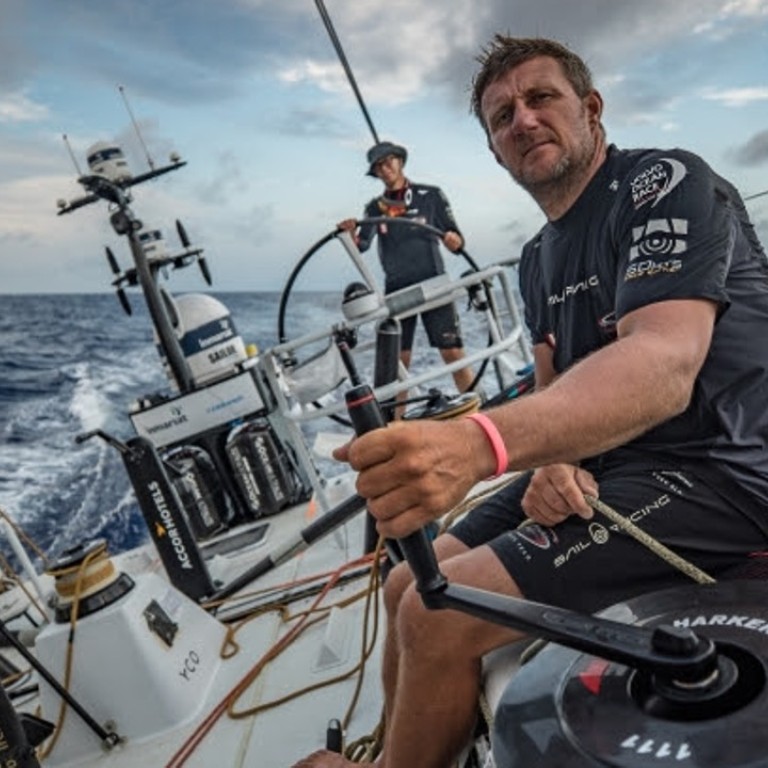
Missing sailor John Fisher ‘likely unconscious’ before he hit the water: Crew of Hong Kong-owned boat release timeline of events
Briton unclipped his safety tether just as the boat suffered a sudden change of direction and was knocked into the sea by a fast-moving piece of equipment
Missing Sun Hung Kai/Scallywag sailor John Fisher was likely unconscious before he hit the water after being hit by the mainsheet pulley system that knocked him into the sea, according to a timeline of events released on Wednesday by the heartbroken crew of the Hong Kong-owned boat as they abandoned leg seven of the Volvo Ocean Race and headed towards the coast of Chile.
Fisher is presumed to be lost at sea after falling overboard into the treacherous Southern Ocean on Monday night (Hong Kong time) some 1,400 miles from Cape Horn, with Scallywag around 200 miles behind the rest of the six-boat fleet at the time.
The report says Fisher had unclipped his safety tether to clean up a furled sail. At that very moment, the boat experienced a sudden change of direction – a highly dangerous accidental crash gybe – as it swept down a large wave and the 47-year-old Briton was hit by the equipment that swung violently across the boat and knocked him into the sea.
The conditions were challenging when Fisher, who was wearing a survival suit with a wetsuit hood and gloves and a life jacket, unhooked himself with 35-45-knot winds and 4-5 metre seas.
Tim Newton, the Scallywag team manager, said skipper David Witt and navigator Libby Greenhalgh furnished a timeline of events to ensure accurate reporting of the incident.
“This is the worst situation you can imagine happening to your team,” said Newton. “We are absolutely heartbroken for John’s family and friends. I know for David, he has lost his best friend. It’s devastating.”
The Scallywag crew had yet to confirm its plans as they headed towards the west coast of Chile, which is the closest landfall and is the safest route given the fact that they are still sailing through dangerous seas. The rest of the fleet are making their way to Cape Horn before turning north towards the finish line in Itajai, Brazil. Leg seven started in Auckland, New Zealand.
On behalf of everyone at @teamAkzoNobel, our skipper Simeon Tienpont sends a message of support to the family of John Fisher and the sailors and support team at @scallywaghk pic.twitter.com/IH7LPzM6LI— teamAkzoNobel (@teamAkzoNobel) March 28, 2018
Newton said the crew members were distraught but were focused on reaching shore and safety.
“This situation isn’t over yet for our team,” Newton said. “The conditions are extremely challenging, with strong winds and a forecast for a building sea state over the next couple of days. Our sole focus, with the assistance of Race Control in Alicante, is to get the team into port safely.
“Once we have achieved that, we have time to debrief more fully and ensure that any lessons that can be learned from what happened to John are incorporated by the rest of the fleet going forward.
“That would be a tremendous legacy for John, who spent so much of his time passing the learnings from his lifetime of experience at sea on to the younger sailors on our team.”
Race Control said the Maritime Rescue Coordination Centre was continuing its search for Fisher.
The following is the timeline of events, word for word, as provided by the Scallywag crew via Race Control.
TIMELINE OF EVENTS
• On Monday, 26 March, SHK/Scallywag was racing in Leg 7 of the Volvo Ocean Race from Auckland, New Zealand to Itajai, Brazil, approximately 1,400 nautical miles west of Cape Horn
• Weather conditions were 35-45 knots with 4 to 5 metre seas with showers reducing visibility. It was 15 minutes before sunrise
• The team was sailing with a single reef in the mainsail and the J2 jib. The Fractional 0 (FR0) sail was hoisted but furled
• At roughly 1300 UTC SHK/Scallywag surfed down a large wave leading to an accidental crash gybe
• John Fisher was on deck, in the cockpit. At the time, he was moving forward to tidy up the FR0 sheet and had therefore unclipped his tether
• As the mainsail swung across the boat in the gybe, the mainsheet system caught John and knocked him off the boat. The crew on board believe John was unconscious from the blow before he hit the water
• He was wearing a survival suit with a wetsuit hood and gloves and a life jacket
• The JON buoy and the horseshoe buoy were thrown off the back of the boat to mark the position
• It took some time to get the boat under control and motor sail back to a position near where the man overboard occurred
• At 1342 (UTC), the team informed Race Control, by email, that there was a man overboard and they were returning to the MOB position to start a search pattern
• With input from the Maritime Rescue Coordination Centre and Race Control in Alicante, a search and rescue operation was carried out for several hours but there was no sign of John, the horseshoe buoy, or the JON buoy
• With weather conditions deteriorating, a difficult decision was taken to abandon the search and preserve the safety of the remaining crew

